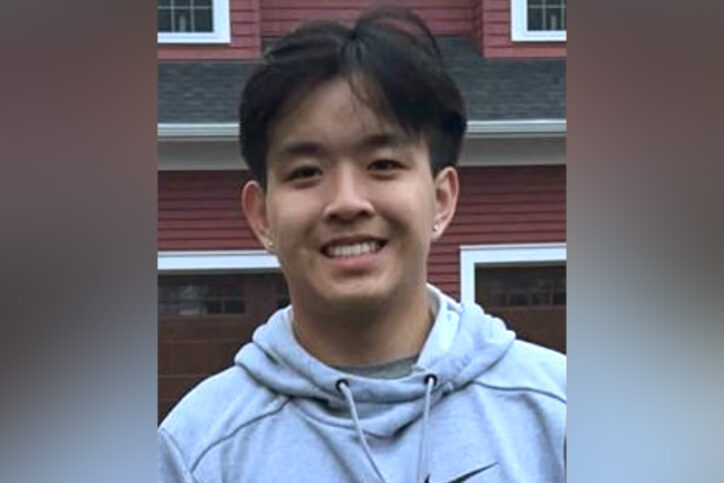Adjusting to sitosterolemia took time, but Justin is now on a healthy path

After Justin Zhao was diagnosed with the rare metabolic disorder sitosterolemia five years ago, the toughest part of treatment was watching his three siblings eat chocolate when he couldn’t.
Sitosterolemia is a genetic disease that causes the fatty substances, or lipids, from plant-based foods such as nuts and vegetable oils to build up in the arteries, increasing the risk of heart attack and stroke.
Yet, being diagnosed with a life-changing condition initially didn’t upset Justin. “I honestly didn’t think it was a big deal because I felt fine,” he recalls. He didn’t realize that continuing to eat mostly what he wanted — including an occasional chocolate — and not exercising enough would eventually trigger a serious warning from his care team at Boston Children’s. They warned that his condition would worsen if he didn’t change his habits. “Then I got serious about it.”
Now 18, Justin appreciates how the Preventive Cardiology Clinic helped him manage a condition that has no universal form of treatment but rather a process that relies on collaboration between patient, nurse practitioner, cardiologist, and dietitian.
Diagnosing a rare genetic disease
Because there aren’t many documented cases, diagnosing sitosterolemia isn’t easy. Justin first caught the attention of his primary care doctor by displaying symptoms of high cholesterol. He had cholesterol deposits on the skin of his elbows and knees, and his Achilles tendons widened. But a cholesterol screening detected only mildly elevated LDL levels, pointing to another condition. Justin was referred to Boston Children’s, where the Preventive Cardiology Clinic team believed genetic testing would offer an answer. Indeed, it confirmed sitosterolemia.

“It’s challenging to diagnose and easy to see how this could be missed in patients,” says Dr. Elizabeth Yellen, a Boston Children’s cardiologist. “It is believed many cases go undetected.”
The next question was what to do next. Justin is the first, and so far only, patient the clinic has seen with sitosterolemia. Dr. Yellen and pediatric nurse practitioner Jennifer Bachman researched the disease and spoke with clinicians across the country who had treated it. Fortunately, despite the disease’s rareness, the mechanism for how it works is still understood, which helped the team determine how to treat Justin, Bachman recalls. For instance, they knew the medications that are used to lower the lipid values of similar conditions could also work to combat sitosterolemia.
Collaborating on a healthy diet and improved lifestyle
Justin’s mom, Joey, appreciates how Bachman, Dr. Yellen, and dietitian S. Skylar Griggs make daily treatment seem achievable. They always answer her questions, often communicating through an interpreter who speaks Cantonese. The clinical team, in turn, relies on Justin’s and Joey’s feedback to see what works and what doesn’t to collaborate on dietary and exercise goals he can reach.
Justin can no longer eat certain seafoods, peanuts, almonds, and avocados. Aside from missing out on chocolate, he also had to eliminate plant oils such as corn, soybean, and palm — a tall order because some of them are used in foods Justin had enjoyed at the Chinese restaurant owned by his father, Ying.
But Griggs viewed Justin’s dietary guidelines as an opportunity to encourage him to say “yes” to a broader palette of foods he would eventually appreciate. It’s okay to have lean protein sources such as chicken and tofu. While servings of broccoli and cauliflower had to be reduced, Justin could eat all other vegetables and all fruit. He is happy the menu at his father’s restaurant isn’t entirely off limits; he likes Bok choy.

Justin’s mom has helped him adhere to his daily medication schedule. And the clinic’s warning to get serious about treatment not only moved Justin to finally eat healthy, but it also motivated him to exercise. He played lacrosse and ran cross-country at his high school in Fairhaven, Mass.
This fall, he started a new chapter, one that requires him to stay true to his diet, exercise, and medication routines as he studies pre-occupational therapy in college and lives away from home for the first time. He’s up for the challenge, and has his care team to thank for that. “They’ve been helpful,” he says. “I don’t know what I would have done without them.”
Learn more about the Preventive Cardiology Clinic, or make an appointment.
Related Posts :
-

Low-carb or low-fat? Study pinpoints better diet
Despite the popularity of low-carbohydrate diets, health experts have pushed low-fat diets for the past 50 years, citing saturated fat as ...
-

I tried the keto diet to help my epilepsy and it changed my life
My name is Dennis. I’m 15 years old and live in East Greenwich, Rhode Island. Two years ago, I started ...
-

Dietitian Tara McCarthy cooks up a meaningful New Year’s resolution
For many people, the new year offers an opportunity to embrace fresh starts and self-improvement goals. But for Tara ...
-

Weight loss: When scientific paradigms collide
David S. Ludwig, MD, PhD, co-directs the New Balance Foundation Obesity Prevention Center at Boston Children’s Hospital. ...





